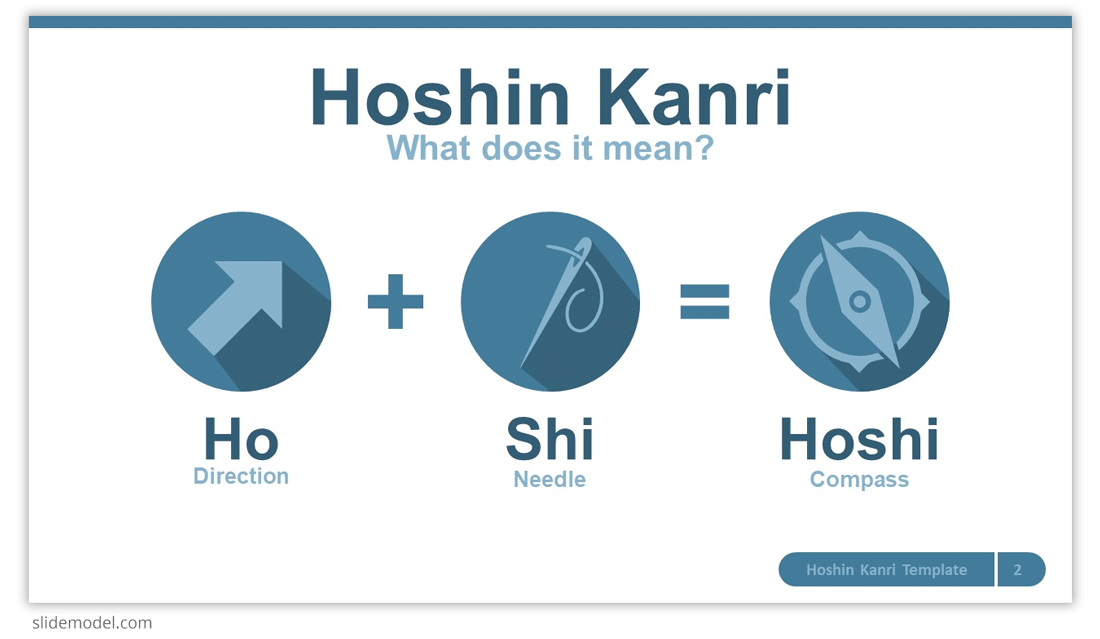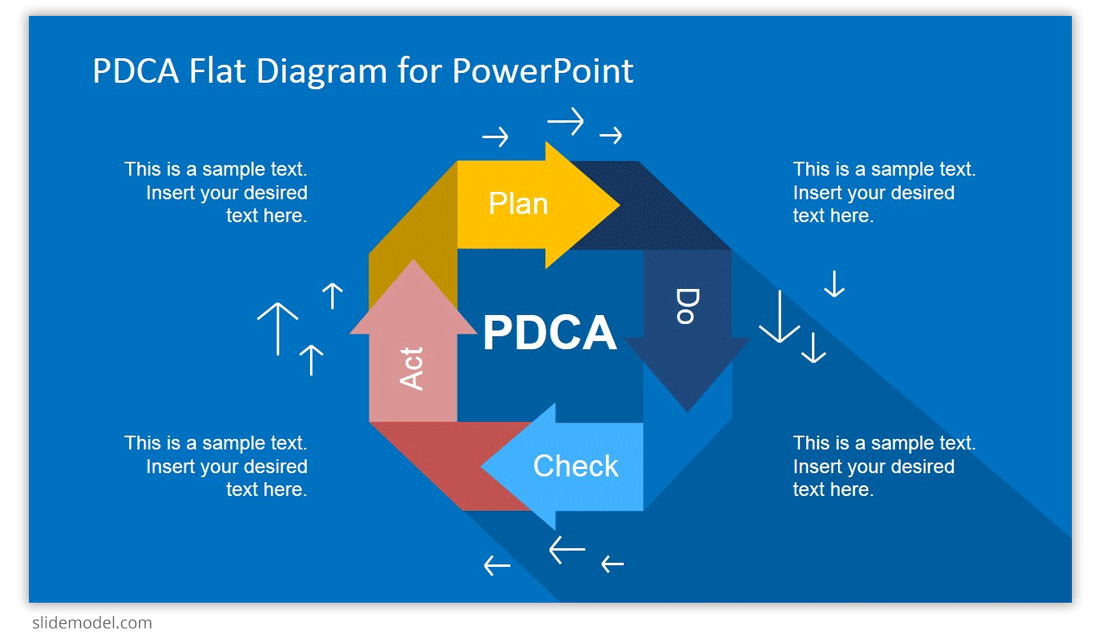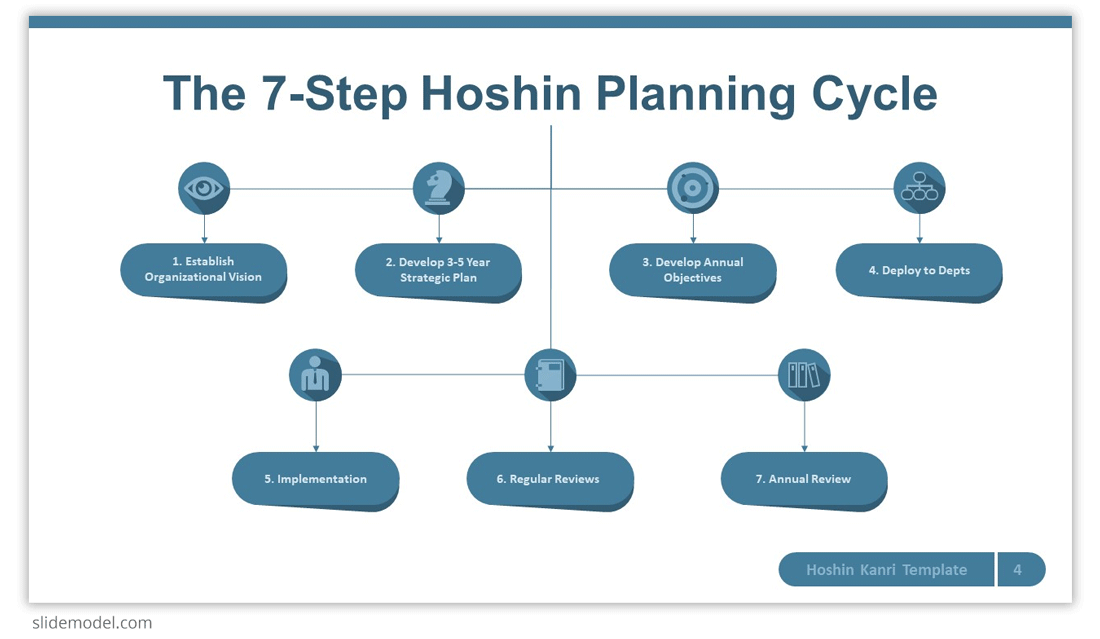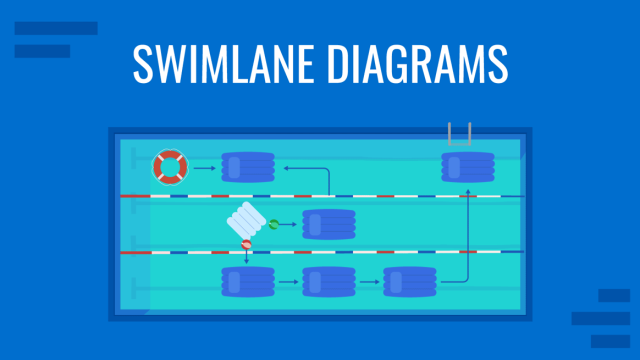
Without successfully implemented strategic planning, businesses are doomed to fail. That’s a well-known fact, so most companies regularly schedule planning sessions, create reports, forecast and so on. The real issue? All those “paper” efforts rarely result into action. Strategic planning, or more specifically, strategic execution fails as executives are tied with too many priorities, and they allow the active review processes to go amis. Inefficient communication further contributes to the lack of clarity in strategic plans.

Ready to change that? In that case, you may want to learn more about what is Hoshin planning.
Hoshin Kanri Explained
Hoshin Kanri Strategy PowerPoint Template by SlideModel
Hoshin Kanri is a strategic planning methodology. Its purpose is to ensure that key goals are communicated across the organization, then put into action. The ultimate goal of the Hoshin planning process is to improve communications company-wide, and to reduce waste that is often the result of poor management processes and lack of direction. Some of the well-known Hoshin Kanri examples include Toyota, HP, and Xerox business planning initiatives. In fact, Toyota alone has used Hoshin Kanri since the 1960s. The company’s long-lasting success clearly illustrates that this approach leads to positive results.
Originally, the Hoshin Kanri methodology can be traced back to post WWII Japan. At that time, Japan was in tatters. The country needed to rebuild its infrastructure and reestablish itself within the global community. The Japanese also faced additional challenges. Their conditions of surrender meant that they had to rebuild their economy without revitalizing their military presence.
One of the initiatives during this time was led by Joseph Juran and W. Edwards Deming. They combined the concepts of management by objective and the PDCA cycle, both of which are influential in Hoshin Kanri.

Today, Hoshin Kanri is implemented as a lean management methodology that ensures that any organizational strategy that is created is executed successfully. It accomplishes this by identifying the best ways to executing strategy deployment and policy deployment on both the micro and macro levels.
Two of the major encompassing components of the Hoshin planning process are PDCA and Catchball. These help to create synergy and alignment at all organizational level. The result is a cascading effect where strategic planning goals lead to the creation of more actionable goals down the management structure as well as across business areas.
Hoshin Kanri Approach To The Communication Flow
The ultimate goal of incorporating Hoshin Kanri methodology is to make sure that proposed strategy changes drive progress and action at every level within the company. By applying its key methods, you can ensure that every employee (from CEO to juniors) know the ultimate goal and “pull” in the same direction at the same time.
Hoshin Kanri is effective because it allows an organization to focus on long term goals while also achieving its short-term objectives. With Hoshin Kanri, vital, organizational goals are communicated through the company in ways that are relevant to everyone. As a result, buy-in from supervisors, mid-level managers, and the rank and file is increased. Decisions made at every level are then more likely to contribute to the organization’s strategic goals. This buy-in is obtained by using a simple, but effective technique called the “catchball process”.
The Hoshin Kanri Catchball Process

Catchball is a lean technique that is part of Hoshin Kanri. It is a process of passing ideas up and down and back and forth in the organizational structure. It allows everyone to be involved in and contribute to forward momentum in the organization, rather than simply being subjected to it.
One of the problems that organizations often have is that strategic decisions are made at the top without feedback from the people who will be impacted by those decisions, and who are expected to make those strategies work. The result of this is that front line managers and others are resentful, and there’s an overall lack of cohesiveness. Hoshin Kanri attempts to minimize and ultimately eliminate these internal frictions.
Keep in mind that the overarching goal of Hoshin Kanri is alignment. Strategic goals can only be accomplished when tactics and operations work towards those goals. Tactics are plans developed by managers to achieve their objectives. Operations are the work done by employees to fulfill the goals of management.
The catchball process gets everyone involved in the planning process. The employees at the organization at every level of management, take the company goals, then create their own objectives for working towards those goals.
Here’s how the aforementioned catchball process works. Imagine that upper management has a meeting, and creates an organizational goal. They then toss that ball down to the next organization layer (management). The management team analyzes the goal, identifies potential roadblocks, and comes up with ideas that can be used to accomplish that goal in tangible ways. Then, they toss the ball back up to the executive layer.
Once there is a consensus between executives and management, the catchball continues. Department heads, supervisors, and others in the organizational structure have their time with the ‘ball’, and contribute their own ideas. Eventually, not only are the goals propagated across the organization, but specific strategies for accomplishing them. These strategies not only take in the input of people across the organization, but they also accommodate the unique needs and struggles that various teams may face.
As with any other lean management technique, it takes practice to make catchball work. The first attempts at it are likely to be a bit rough. Organizations that have a supportive culture are definitely at an advantage here. Finally, it’s important to remember that catchball is about collaboration. It only works when every management layer, and every business area is invested in the success of another. One upmanship and punitive approaches can destroy the effectiveness of this technique.
The 7 Steps of Hoshin Planning

Establish The Organizational Vision
This step involves asking and answering questions about your organizational vision, business planning, and execution. This is where you will identify and evaluate existing policies and procedures, map out your organizational structure and operational management structure, identify your current long term goals, and solidify your vision/mission statements.
Develop Breakthrough Objectives
It can help to think of your breakthrough objectives as your three to five-year plan. To accomplish these, your organization will have achieved meaningful growth. Some examples of breakthrough objectives are:
- Expanding into a foreign market
- Introducing a new product line
- Using a new software development methodology
- Adopting a new technology throughout the organization
Develop Annual Objectives
Of course, it isn’t practical to have breakthrough objectives without dividing those into manageable chunks. This is where annual objectives come in. Imagine if your breakthrough objective is to expand into a foreign market. Your annual objective may be to identify the first country where you will establish operations. The clearer these objectives are the better. This step sets the foundation on which future action will be taken.
Deploy Annual Objectives
You develop your objectives at an organizational level. In order to achieve them, you must set workable goals at the team or departmental level. This means developing priorities and establishing the metrics that will be used to determine whether they have been executed successfully. The deployment of annual objectives is the cascading process that brings every layer of the organization into alignment with the company’s objectives. The is also the stage where people receive their ‘walking orders’, and where each department is integrated into the overall strategic plan.
The deployment of annual objectives step is best illustrated with the X matrix or Hoshin kanri matrix. It is where detailed action plans are developed, and employees identify opportunities to improve the processes they are using while working towards their goals.
Implement Annual Objectives
It is during this step where action steps are executed, by using a problem-solving approach that is the best fit. SCORE, a lean event is implemented here. That is selecting a process to work on, clarifying the problem to be solved, organizing the team that will carry out the action, running the event, and evaluating the results.
Schedule Monthly Reviews
This is where it is determined how successful teams are in meeting their deliverables. In the event that teams are falling behind, it is during this phase that team members can identify problems and assign action steps that will enable impacted teams to catch up. The monthly review process creates needed accountability, but also provides means for those who need help. Without this process, small problems and roadblocks can easily become unmanageable over time.
Schedule Annual Review
At the end of each year, the seventh step involves thoroughly reviewing the established objectives. Once the organization understands where they are in term of achieving, they can begin to make adjustments in their plans for the next year. This can include playing catch up for goals not met, or finding the best way forward if they are ahead.
The ultimate benefit of Hoshin planning is that it helps organizations to eliminate the disconnects and resulting miscommunications that often happens as a result of strategic plans being made at the C-level without consideration as to how those plans will be executed across the organization. Because the consensus and buy-in are emphasized from the start, a feeling of ownership is fostered across the organization. Your company operates as a “united front” and your key priorities become personal agendas of employees.


